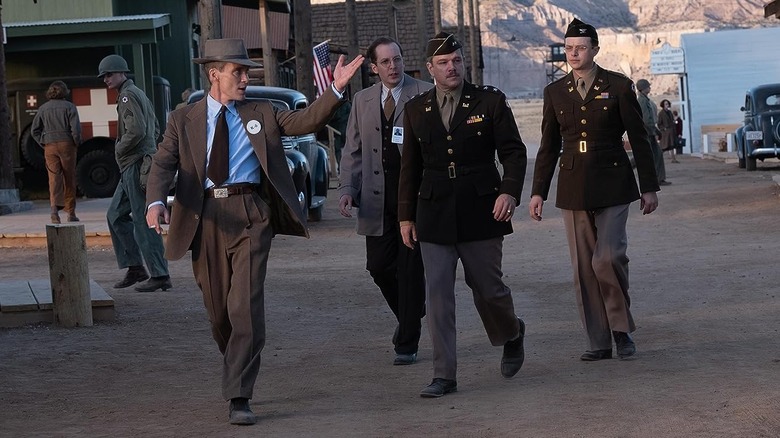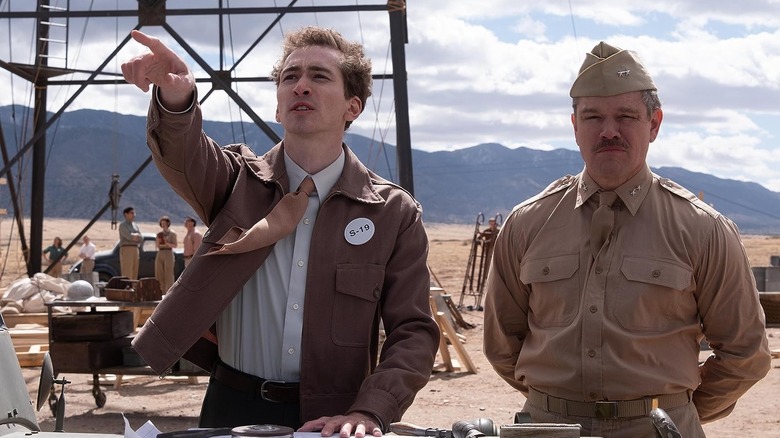Why Christopher Nolan Axed An Entire Month Off Oppenheimer's Filming Schedule
Christopher Nolan is one of those directors whose films you watch and can immediately tell nothing was left to chance (well, almost nothing). Whichever way you feel about the stories he prefers to tell, it's clear he knows precisely what he wants to say and how to say it during any given moment. It's a quality that's allowed him to emerge as the rare true auteur working on a blockbuster scale over the past 20 years. After all, studios love a thrifty storyteller who makes the most of every dollar they spend, and even his detractors would have to admit Nolan excels in that department.
Even by his standards, however, Nolan was extremely fastidious when it came to shooting "Oppenheimer," and for a very good reason. Speaking on the "Team Deakins" podcast (via Variety), the film's production designer Ruth De Jong ("Manchester by the Sea," "Twin Peaks: The Return") said, "It felt like a $100 million indie." Obviously, a $100 million budget is nothing to sneeze at, but by Hollywood standards, that's a modest sum for a summer tentpole, even one where most of the "action" consists of men sitting in rooms talking to one another. It's also roughly half the cost of Nolan's last film, "Tenet," which posed a problem when it came time to recreate a period-accurate Los Alamos for "Oppenheimer."
Upon realizing it would cost $20 million to reconstruct the town the way De Jong intended, Nolan did "the most incredible thing [to] achieve all of the desired looks and designs," De Jong said. Specifically, after going off to do some "homework" (as Nolan told De Jong), he went and shaved 30 days off the 85-day shoot that had originally been planned, freeing up the funds they needed without inflating the budget in the process.
'That is a lot of money we get back!'
Nolan has always been a resourceful filmmaker devoted to keeping his movies as practical as possible, so much so it's hard not to speculate that he would've set off an actual nuclear explosion just to avoid having to use a CGI one in "Oppenheimer" (had there been a safe way to do so). It's also why he barely even blinked before trimming the film's shooting schedule to ensure De Jong could rebuild Los Alamos the way they wanted. There were other benefits as well, like how this made it easier for Nolan to shoot in the real-world locations where the film takes place. De Jong explained:
"[Thomas Hayslip], the executive producer, said, 'Ruth, you can't go to Berkley, you can't do this.' But we have to go to Berkley. That is 'Oppenheimer'! The producers were asking what I could do on my end to shrink [the budget]. Tom then comes into my office and says, 'Chris is going to shoot this in 55 days.' That is a lot of money we get back! At that point, you feel like I have to deliver above and beyond because he just went and gave up his days. He, more than anyone, knows what he wants to get in every single day and how he wants to get it and he goes from 85 to 55 days."
In a year that's seen multiple studios trying and failing to spend their way into profitability at the box office, it's refreshing to hear about filmmakers squeezing every drop they can from the figurative oranges that are their budgets instead. That Nolan has been rewarded for his efforts with one of his highest-grossing films ever (and an R-rated, three-hour adult drama at that) just makes the outcome that much sweeter.

